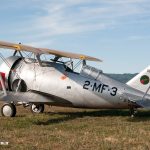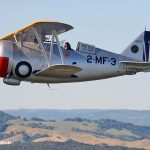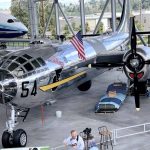text by Stephen Chapis
images by Luigino Caliaro
The Grumman F3F had the dubious honor of not only being the last biplane fighter to embark aboard a U.S. Navy aircraft carrier, but it was also the last such fighter to enter service with any branch of the U.S. military. With monoplanes on the horizon and the clouds of war gathering, Leroy Grumman’s robust Flying Barrel (as the type was affectionately known) served honorably in the years just prior to America’s entry into WWII.
History records the F3F as being Leroy Grumman’s third fighter design, but the type could easily have emerged simply as a new variant of his previous effort – the F2F. Indeed, the F3F featured only a few minor modifications to address the F2F-1’s stability problems and excessive proclivity for spinning. Sadly, the prototype XF3F-1 (BuNo.09727) crashed on March 22, 1935, just two days after its first flight; company test pilot, Jimmy Collins, lost his life when the aircraft broke apart during dive tests. A second prototype was built and oddly – perhaps prophetically – assigned the same BuNo. It too was lost (on May 15, 1935) when its pilot, Lee Gehlbach, was forced to bail out during an unrecoverable flat spin. Thankfully the third prototype (again bearing the same service number as the first two XF3F-1s) successfully completed its terminal velocity dive tests; the U.S. Navy formally took delivery of the fighter on July 10, 1935.
In the spring of 1936, the 54 F3F-1s which Grumman built at their plant in Farmingdale, New York plant were distributed amongst two U.S. Navy squadrons, VF-5B and VF-6B, and a single U.S. Marine Corps squadron – the San Diego-based VF-4M (re-designated VMF-2 in July 1937). By the end of that year, VMF-2 had been completely re-equipped with F3F-2s and played a role in the filming of Warner Brothers’ 1941 feature film, Dive Bomber. Amazingly, pilots assigned to this squadron during that period included future Medal of Honor recipients Gregory Boyington, Henry Elrod, and Robert Galer. In January 1941, VMF-2 moved to Marine Corps Air Station (MCAS) Ewa, which was located just west of Pearl Harbor on the southern shore of Oahu, Hawaii. Among the fighters which made that trip to Ewa was the aircraft featured here, F3F-2 BuNo.0972. Chris Prevost presently owns this charismatic, if somewhat corpulent, biplane, one of only two airworthy Flying Barrels.
While the world’s worst novel reputedly begins with the infamous line, “It was a dark and stormy night…”, that statement could truthfully begin the story about our subject aircraft. The night of June 24, 1941 was indeed both dark and stormy, but even so, three young Marine aviators launched on a training mission from Ewa in their F3Fs. Leading the flight in our subject aircraft was 1st Lieutenant (Lt) William M. Ferris, with 2nd Lt Warner Hagermann beside him in BuNo.1028 along with 2nd Lt Clyde H. Story in BuNo.1033. Within a few seconds of take-off, they entered the low clouds where they encountered turbulence and showers which occasionally became torrential downpours. The conditions became so frightening that Ferris decided to return home, but with virtually zero visibility and no navigation aids, they struggled – groping through the darkness until the wail of their three Wright R-1820s abruptly ceased upon impact with the wooded slopes of Maui’s 10,000-foot peak, Mount Haleakalá. After an extensive search, a rescue party located the crash site and retrieved the pilots’ bodies. The wreckage of their three F3Fs, however, remained abandoned in situ until the early 1980s when Alan De Coite recovered them for the noted warbird collector, Doug Champlin.
Champlin had previously owned Grumman G-32A c/n 447, the sole, two-place company demonstrator, which combined features from both the F3F-2 and F3F-3, with a 775-hp Wright SR-1820-F52 powerplant. This aircraft first flew on July 1, 1938 and remained a civilian-owned airframe for its entire existence. After the war, the G-32A went on the U.S. Civil Register as N7F and passed through a number of owners before Champlain acquired the biplane in the late 1960s. Sadly this aircraft crashed during an aerobatic demonstration at Oshkosh on August 7, 1971, when an in-flight fire forced both occupants to bail out of the stricken biplane.
In the late 1970s, when he created the Champlin Fighter Museum in Mesa, Arizona, Doug Champlin contacted Herb Tischler at the Texas Aircraft Factory, with a view to rebuilding the G-32A, but Tischler told him that such a project was economically unfeasible. However, the warbird gods intervened – not only were the three Maui F3F-2s rediscovered, but Grumman Aerospace made the technical drawings available, thus making multiple rebuilds possible.
While work began in the mid-80s, all four aircraft returned to the sky in better than new condition by the 1990s. The fact that almost no original parts were reusable did not diminish the craftsmanship involved. Each aircraft was rebuilt to factory specifications except for in areas where safety and reliability were concerned; they were fitted with modern avionics and brakes and powered by a more powerful version of the Wright R-1820. Today, the G-32A is with Comanche Warbirds, Inc. in Texas, Lt Hagermann’s BuNo.1028 is with Kermit Weeks in Polk City, Florida, and Lt Story’s BuNo.1033 is based with Jim Slattery’s Greatest Generation Naval Museum in Colorado Springs, Colorado. Champlin parted with our subject aircraft, Lt Ferris’s BuNo.0972, while still under construction in 1993, selling it to the Lone Star Flight Museum (LSFM) which was then based in Galveston, Texas.
Unfortunately, despite being one of the most important museums of operational aircraft in the United States at the time, the biplane was relegated to static display. On September 13, 2008, a Category 4 hurricane named Ike, roared into Galveston and the storm surge burst through the walls into Lone Star’s hangars. Despite the valiant efforts of museum personnel and pilots, it was impossible to get all of their aircraft to safety before the storm hit. Their Flying Barrel was amongst a number of their airframes which were immersed in a six-foot slurry of seawater and mud. Many thought the F3F was beyond saving, but even so they washed it off with fresh water and preservative before sending it to Ezell Aviation in Breckenridge, Texas. Thankfully, the Ezells were able to clean and treat the airframe thoroughly with an anti-corrosion formula which quickly arrested any damage which the saltwater dunking might have created. It was soon after this point that Chris Prevost, the owner and chief pilot at the Vintage Aircraft Company in Sonoma, California entered the story with his decision to purchase the battered biplane.
Prevost explained his interest in the rare aircraft, stating: “I have always been attracted by aircraft from the Golden Age so, when there was the opportunity to acquire the Flying Barrel, the last biplane fighter in the Navy, I couldn’t let it pass me by. Over the years, I would contact Larry Gregory, the director of the LSFM, about acquiring the fighter, but on every occasion, he told me the aircraft was not for sale. The situation changed radically in my favor after the museum was hit by Hurricane Ike…and…deciding to sell some of the aircraft. I immediately stepped in, and Larry Gregory and I agreed on purchase conditions towards the end of 2012. I was a little worried by the fact that the aircraft had suffered damage during the flooding of the museum, but I must admit that Ezell did an excellent job of the cleaning and preservation work on the airframe, and once we had taken the Flying Barrel to my workshop in Sonoma, its general condition was found to be fairly good…no signs of corrosion. I hoped to return the Grumman to the same condition as when it was operational, and for this reason, I decided to replace the R-1820-55 1,050-hp engine with an original 950-hp R-1820-22. The wings were completely dismantled, and all the fabric areas were recovered using Ceconite. During the overhaul of the aircraft, we rewired the electrical system, fixed the trim, which had been installed inverted, and modified the braking system. We also fitted original wheels from the period, which luckily, I had managed to source. Once the engine, the only component of the aircraft overhauled by an outside company, had been installed, the aircraft was practically ready to receive its present paint scheme, which was selected based on the discovery of a photograph of this aircraft taken on the apron at the Oakland base in November 1938.” (The photograph of which Prevost spoke happened to one taken by the prolific and legendary aviation photographer William T. Larkins, who only recently passed away at the age of 99.)
After more than two-and-a-half years and over 1,000-man-hours of work, Prevost’s Grumman F3F returned to flight in American skies during September, 2012. In terms of the aircraft’s flying characteristics, Prevost noted: “The Flying Barrel was a capable fighter aircraft when it first entered service. Without a doubt, the fact that I had accumulated hundreds of hours on historical aircraft such as the P-40 and P-51 facilitated my conversion onto the type. It is stable and fairly easy to control. Once trimmed out there is no need for corrections with the stick, and it responds well to commands, albeit that its controls are fairly hard to action. The rate of roll is fair, but the thing that gives me the greatest satisfaction with the aircraft is the excellent speed performance, above all in acceleration and climb. Obviously, you pay for this performance with an elevated rate of fuel consumption, and some of the systems in the aircraft are decidedly more spartan when compared to fighters a few years younger. In particular…the retraction system, which was electrically controlled, but we wanted to be faithful to the original…it was restored to its original, manually operated system, a characteristic common to many Grumman aircraft of the 1930s.”
It has now been 86 years since the first F3F took to the skies and given that just 169 examples were built between 1935 and 1939, warbird enthusiasts, regardless of which side of the interminable originality-versus-reproduction debate they stand, are fortunate to have two of these aircraft flying today. They are a fascinating conduit to that brief period in the late 1930s when America was still at peace and the Grumman F3F was at the pinnacle of biplane fighter design.
This article has been updated from its initial publication in Warbird Digest issue #59 during 2015. Since that time, the portly Grumman fighter has changed hands once again. Prevost sold her to Rod Lewis in 2017, and the aircraft now resides in San Antonio, Texas with the rest of the Lewis Vintage Collection.
Special thanks goes to Luigino Caliaro for helping draft this article and the photos. F0r more information about Luigino’s work please visit www.aerophoto.it


















































